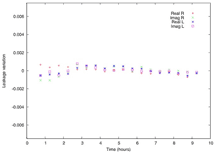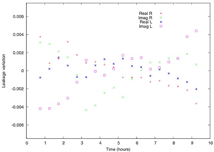
Figure 1: Variation in the antenna polarimetric leakages for antenna 3 at 5.885 GHz during a 10-hour observation.

Figure 1: Variation in the antenna polarimetric leakages for antenna 3 at 5.885 GHz during a 10-hour observation.

Figure 2: Variation in the antenna polarimetric leakages for antenna 3 at 19.265 GHz over a 10-hour observation.
One of the goals of the EVLA upgrade is to be able to produce polarimetric images that are limited by noise rather than systematics. This can be achieved through stable polarizers and software that accurately handles polarimetric calibration and modeling, including the off-axis EVLA antenna response. The design of the polarizers in the antenna feed varies between the different EVLA observing bands. This note focuses on some early characterization of the polarizers at C and K bands and the measurement of the stability of the so-called polarimetric leakage terms. The C and K bands use orthomode transducer and waveguide designs respectively, being representative of the L/S/C and Ku/K/Ka band polarizers.
Measurements show that the C-band leakages vary over an 8-hour synthesis at the level of 10-3, whereas the K-band leakages are a factor of two less stable. These stability measurements were near the thermal limit of the accuracy with which they could be determined. Figures 1 and 2 show the variation of the leakages over an 8-hour period on some of the better behaved antennas (some antennas are worse). Over weeks, the C-band leakages are stable to the level of about 0.01.
A useful rule of thumb for a long synthesis with the EVLA is that the "polarimetric dynamic range" (the peak Stokes I flux density divided by the artifacts in the Stokes Q and U images) is limited to about ten times the absolute stability of the uncorrected time-varying leakage. This suggests that a polarimetric dynamic range of about 1000 should be achievable in reference images using polarimetric calibration that the observatory determines every few weeks. This might be the limit when an observation is formed from many smaller blocks (e.g. short dynamic scheduled blocks). An order of magnitude improvement can be expected when using a polarimetric calibration determined as part of a long synthesis. A further improvement is possible when time-varying leakage solutions are determined as part of the long synthesis. The latter is more important at K band.
For more information, see EVLA memos 131 and 134.